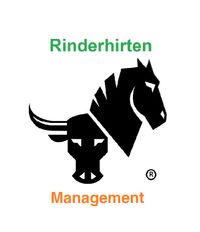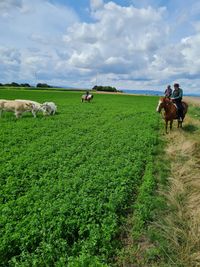Arbeitsreiten am Rind
(RHM)
Die Aufgabengebiete des Rinderhirten-Managements umfasst verschiedene Tätigkeiten, die für die Pflege und Verwaltung von Rinderherden wichtig sind. Dazu gehört das Treiben der Herde in Corrals und das Umtrieb einer Herde. Darüber hinaus beinhaltet die Arbeit auch das Aussortieren von Tieren und das Einfangen entlaufener Rinder.
Ein weiterer wichtiger Aspekt ist die Möglichkeit der Distanzimmobilisierung mittels Blasrohr, jedoch unter der Bedingung, dass ein Tierarzt anwesend ist.
Insgesamt erfordert die Position des Rinderhirten-Managements ein breites Spektrum an Fähigkeiten, einschließlich Tierpflege, technisches Verständnis für Zäune und Ausrüstung sowie die Fähigkeit zur Zusammenarbeit mit Tierärzten für medizinische Verfahren.
Wer übernimmt die Tätigkeiten?
Durch eine abgeschlossene Haftpflichtversicherung sind Schäden die von Rindern oder RH Team verursacht werden abgedeckt. (Einzelschaden bis zu 5 Mio. EURO)
In Deutschland ist es oftmals üblich diese Tätigkeit als Kurs oder Rinder-Kurs anzubieten. Die Kurs-Teilnehmer sind teilweise das erste Mal an Rindern. Ungeübte oder nicht geschulte Reiter/Pferd-Paare übernehmen die Arbeit. Oft wird bei diesen Kurs-Rinder-Arbeiten auf eine Reitlehrer Versicherung hingewiesen. In der Regel deckt diese Versicherung Schäden, die von den Rindern verursacht worden sind nicht ab. Von dieser Art der Rinder-Arbeitsweise distanzieren sich die Rinderhirten RH gUG haftungsbeschränkt wie auch der Rinderhirten e.V.
Begrifflichkeit Arbeitsreiter : Eine Reiter, der mit seinem Pferd an Rinder / Rinderherden im freiem Gelände (Weide, Wald usw.) geschult ist. Die Schulungen lehren an unterschiedlichen Rinderarten und Herdengrössen im Team zu arbeiten. (treiben, selektieren).
Vorteile für die Rinderzüchter und Landwirte
Um eine Rinderherde zu sammeln, treiben oder einzelne Tiere zu sortierten Bedarf es einen hohen fußläufigen Personaleinsatz und Zeit. Bei unserer Arbeitsweise kann der Auftraggeber Zeit und Personal einsparen.
2. Arbeitssicherheit
Der Einsatz von fußläufigen Helfern an Rinderherden verursacht eine extreme Verletzungsgefahr. (z.B. die Geschwindigkeit eines Rindes wird unterschätzt.) Durch den Einsatz der Mitglieder des Rinderhirten e.V. mit ihren speziell ausgebildeten Pferden wird diese Verletzungsgefahr minimiert.
3. Rinderwohl / Tierschutz
Die psychische, wie physische Belastung der Rinder wird stark reduziert.
Bei der klassischen Arbeit an Rinderherden verursachen motorisierte Hilfsmittel Schäden an den Weidenflächen und in schwierigem Gelände, besonders in Landschaftsschutzgebieten, ein nachhaltiges Problem. Durch die zertifizierte Reiter/Pferd Paare werden diese Schäden minimiert.
Entlaufende Rinder halten sich in der Regel in Wäldern oder schlecht zugängigen Gebieten auf. Ausgebildete Pferde nehmen die Rinder wahr bevor der Mensch diese sieht. Durch die Pferde sind wir in der Lage den Rindern auch im dichten Unterholz zu folgen und sie zu stellen. Der im Normalfall oftmals eingesetzte Polizei-Hubschrauber zum Finden der Rinder hat kaum Erfolg und ist sehr teuer. Er kann es nur orten und nicht fangen. Sollte es notwendig sein, kann auch mittels Blasrohr von uns betäubt werden.
Ein Arbeitseinsatz
Das ruhige Treiben einer Heckrinderherde.
In der AGB RHM werden die geschäftlichen Rahmenbedingungen festgehalten.
z.B. Arbeitsablauf, Rechnungswesen, Bild-und Tonrechte,


.jpg/picture-200?_=16a11cafd88)

.jpg/picture-200?_=1798e582d30)
_1.jpg/picture-200?_=17e39fcfc20)
